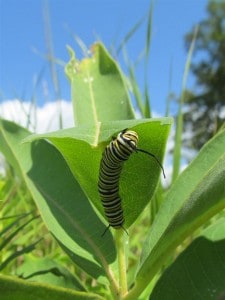Over the past couple of weeks, the milkweed plants in my perennial garden have literally bolted out of the ground. The Common Milkweeds already have flower buds, and the patch of Butterfly Milkweed is much larger than it was last year. However, as I admire these remarkable plants, I can’t help but wonder whether Monarch butterflies will ever visit them this year, because the forces working against this iconic insect are many. Still, maybe there is room for a least a little optimism. Last Saturday, the first Monarchs to arrive back in the Kawarthas flitted over the Carden Alvar near Kirkfield, and there is finally serious talk of a recovery plan for the Monarch.
Back in January, the overwintering numbers reported by World Wildlife Fund Mexico were discouraging. The total area occupied by Monarch colonies at overwintering sites was only 0.67 hectares, compared to a 2004 – 2014 average of 3.51 hectares. This is the smallest overwintering population ever recorded. According to Dr. Chip Taylor, director of Monarch Watch at the University of Kansas, the main reason for the decline is the loss of Monarch habitat, which really means a loss of the milkweed plants on which the species depends. The finger of blame can be pointed primarily at the adoption of herbicide tolerant (HT) crops. The invention of HT corn and soybeans has made growing more efficient, since it allows farmers to spray and kill off everything else – clearly bad news for milkweed and Monarchs.
When tilling was used to control weeds in the corn and soybean fields of the Midwestern United States, some milkweed survived the process. However, with the adoption of HT crop lines, the use of glyphosate has all but eliminated milkweeds from these habitats. Healthy Monarch habitat in the Midwest is crucial because this region produces more Monarchs per acre than anywhere else on the continent. In other words, Monarchs are losing the milkweed in the most important part of their northward migration route, namely the area bordered by Kansas in the southwest, the Canadian border to the north and Ohio to the east.
According to Taylor, the acreage of corn and soy has increased by 20 million acres over the last seven years. This increase is largely due to the demand for ethanol, which has had the effect of driving up the price of corn. In much of the Corn Belt, farmers have removed hedgerows and narrowed field margins, with little habitat remaining for any form of wildlife. Grasslands, including some of the last remaining native prairies, rangelands, wetlands, and even conservation lands – have been plowed under to produce more corn and soybeans. Most of these acres formerly contained milkweeds.
Taylor estimates that since 1996, urban development has also eaten up at least 17 million acres of habitat that was once used by the eastern North American population of Monarchs. He also points out that there are habitat losses due to excessive mowing and use of herbicides along roadsides. These were significant milkweed and monarch habitats in the past. In many areas, milkweed is still listed as a noxious weed. In Ontario, however, milkweed has now been delisted as a noxious weed.
Taylor concludes that, in total, at least 167 million acres of Monarch habitat have disappeared since 1996. This is an area almost equal in size to the entire state of Texas! Because of the economic forces involving crop production and human population growth, these losses will continue. It is clear that if our goal is to save the Monarch migration, ways must be found to mitigate the loss of Monarch habitat.
New research from University of Guelph has come to the same conclusion as Taylor. The researchers suggested that Monarch populations were four times more sensitive to the loss of milkweed on their breeding grounds than the loss of the forested habitat in which they spend the winters. Using their model, the scientists found a 21 percent decline in milkweed abundance between 1995 and 2013. The largest declines, namely those in the American Midwest, line up with the largest declines in the butterfly population.
Weather, too, plays a role in how well Monarchs fare. 2012 and 2013 both deviated from normal with 2012 being too hot and 2013 being too cold at critical times during the butterfly’s life cycle. The poor weather further contributed to low overwintering numbers. Monarch numbers will rebound, but only if the weather cooperates AND there is sufficient milkweed. On a more positive note, Taylor believes that while we will never get back to the large populations of the 1990s, there is still enough milkweed to produce Monarchs in sufficient numbers to colonize 3-4 hectares of the forests in Mexico. However, this will require favorable weather conditions over the next several years – something that is far from certain in this time of climate change.
A Recovery Plan
Although Monarchs can be found throughout the U.S. and southern Canada in the summer months, most of the population utilizes two critical areas, which Taylor calls the “milkweed/monarch corridor”. They are 1) the spring breeding area of Texas, Oklahoma and parts of Kansas and 2) the upper Midwest or Corn Belt. Monarchs arriving in the spring breeding area in March lay eggs on milkweeds, and most of the adults that develop as a result of this reproduction move northward into the upper Midwest in May and early June. They eventually spread out over the north from the Dakotas to Ontario and even on to the Maritime Provinces. However, it is the production of the Monarchs in the Corn Belt that is critical. Tagging data has shown that most of the Monarchs reaching the overwintering locations in Mexico originate from the Corn Belt.
Taylor’s vision is that the Monarch migration can be saved if there is commitment to offsetting on-going losses of habitat by planting milkweeds and nectar plants in areas from which they have been extirpated. This will require the development of greater capacity to restore milkweeds than exists at present. It will also depend up marketing and outreach to engage citizens, government agencies, corporations, farmers, nurseries and schools. Taylor believes that offsetting the annual habitat loss will require the establishment of at least 5-15 million milkweeds via the planting of seeds and plugs.
Some heavyweight support for a recovery plan was announced at this year’s NAFTA summit in Toluca, Mexico. The leaders of Mexico, the United States and Canada agreed to take measures to “conserve the Monarch butterfly as an emblematic species of North America.” More than 100 scientists, Nobel Prize winners and environmentalists had written to Pena Nieto, Harper and Obama before the summit, calling on them to establish a “milkweed corridor” through the three countries. The petitioners called for the massive planting of milkweed along roadsides and toxin-free buffer zones in Canada and the United States.
So, it’s simple. If we want Monarchs, we need to plant more milkweed, and to protect the milkweed we already have. The real battle, however, is restoring milkweed in the all important “monarch/milkweed” corridor of the U.S. Visit http://monarchwatch.org/ for information on all aspects of Monarchs and their future. You can also make a vitally important financial contribution by clicking on “Chip in for Monarch Watch!”

